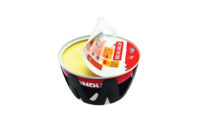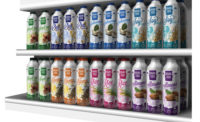Sustainability touches every aspect of the dairy industry. Consumer demand for more environmentally friendly products is a driving force, prompting changes to packaging materials that are more easily recycled, contain recycled content, are source-reduced and/or are derived from renewable sources. In addition, corporate sustainability initiatives are influencing adoption of equipment that consumes less energy and water and boosts product shelf life (thereby reducing food waste).
“Companies are looking at their carbon footprints, looking for films that are compostable, recyclable or made from recyclable materials or products,” said Christine Duncan, marketing manager at ProMach – Flexibles, Covington, Ky.
Murray Bain, vice president of marketing for Smithville, Ontario-based Stanpac, agreed that the trend in ice cream and other packaging is consideration of the impact on the environment.
“Public perception seems to point toward an interest in alternatives to plastic,” he said. “Since the BBC screened Sir David Attenborough’s Blue Planet II in 2017, drawing attention to the dire problem of plastic waste in our oceans, thousands of people have been inspired to find alternatives to all kinds of plastic containers. Ice cream companies large and small are ever increasingly asking for environmental options.”
Stanpac’s renewable ice cream packaging is made from Sentinel ice cream board from Evergreen Packaging, a paperboard coated with a bio polyethylene derived from sugar cane. The first user of the eco-minded pint packaging is Coconut Bliss, a family-owned producer of plant-based frozen desserts.
Graham Packaging and dairy producer Danone, Paris, were short-listed as finalists in the sustainability category of the World Dairy Innovation Awards for their first-in-market Black Eco Design, the Adjacent pigmented black bottle.
“The uniqueness of Adjacent lies in the fact that it offers the benefit of opacity found in traditional carbon-based bottles while permitting detection in recycling streams,” said Eric Englert, director of sales, dairy and functional nutrition at Graham Packaging, with U.S. headquarters in Lancaster, Pa.
A new handled polyethylene terephthalate (PET) milk jug also offers sustainability benefits. Based on patented Bottleone technology from Practically Impossible Labs, the handled PET container is designed to replace the traditional 1-gallon high-density polyethylene (HDPE) milk jug and can be produced in-house on an ErgoBloc blowmold/fill machine from Krones Inc., Franklin, Wis. Bringing container production in-house and integrating it with filling streamlines operations and reduces warehouse requirements.
“The problem with the traditional milk jug is it can’t stack,” said Jon Larson, director – sales, PET technologies for Krones Inc.
So dairies rely on plastic crates (or corrugated cases) to provide stackability. Crates typically hold four 1-gallon jugs and must be returned and cleaned. The handled PET jugs can be shrink-wrapped, eliminating the crate or case while allowing higher stacking and better cube-out.
The PET container offers other advantages, too. Its clarity delivers better product visibility than HDPE. In addition, it also offers a better oxygen barrier, a longer shelf life and a hermetic seal; it also is more shatter-resistant. Since the neck finish on the PET container is the same as the HDPE jug, the same closure can be used.
Sustainability goes beyond primary packaging
Sustainability efforts extend to secondary packaging. For example, a Walmart initiative called Project Gigaton has set a goal to eliminate 1 billion metric tons of greenhouse gases from its global supply chain by 2030.
“As part of that initiative, Walmart seeks secondary packaging that can be recycled,” explained Rick Gessler, vice president of engineering for St. Paul, Minn.-based Delkor Systems. “To meet this call, we’ve designed the Turbo case and Cabrio case to be completely recyclable with corrugated paperboard and recyclable plastic shrink wrap.”
Labels are becoming more sustainable, too. A thin-gauge film-handling option on the SLX shrink sleeve labeler from Axon, a ProMach product brand, allows the machine to run the thinnest gauges of film at speeds up to 800 containers per minute. There’s an “ongoing need to reduce packaging material costs in general, and the ability to run lighter gauge, lower cost shrink-label films, in particular,” said Bob Adamson, director of marketing, global filling, prime labeling and integrated solutions at ProMach Filling Systems.
In some cases, labels such as the ClearIntent portfolio from Glendale, Calif.-based Avery Dennison can prevent contamination of HDPE and PET container recyclate. Careful selection of label materials also can allow use of more recyclable containers. For example, Avery Dennison’s Pentalabel eklipse light-blocking shrink film “offers superior brightness and whiteness, high-performance shrink percentages to enable design freedom, and the opportunity to lower costs by eliminating high-barrier/multilayer primary containers,” said Michael Leroy, senior product manager – paper, Avery Dennison label and packaging materials.
Other major trends include food safety, consumer convenience, shelf impact and packaging line flexibility.
Food safety a priority
A stronger emphasis on contamination prevention is spurring the development of equipment designed for easy cleaning with minimal labor and growing use of inspection systems.
“In order to comply with strict food safety regulations, dairy and food producers increasingly opt for advanced hygienic filling and packaging technologies,” reported Markus Schlumberger, managing director of sales, Ampack GmbH, Centre of Competence for Bosch Packaging Technology, Waiblingen, Germany.
Ultra-clean machines offer an extended, preservative-free shelf life for refrigerated products, while aseptic machines offer shelf lives of up to a year outside the cooling chain. For extended-shelf-life products, Bologna, Italy-headquartered IMA offers the Fillshape flexible pouch filler. It combines continuous rotary motion pouch assembly and filling with package sterilization. The company also supplies equipment for aseptic products. Its Hassia aseptic stick pack machine currently ranks as the only FDA-filed, low-acid aseptic stick pack machine in the United States and is said to be ideal for dairy and nondairy creamers.
For frozen desserts, there is a push to eliminate metal rings from packaging for bulk products.
“The rings can cause cuts to all the handlers and create the risk of blood and/or bloodborne pathogens depositing into the ice cream and, by default, being consumed by the customer,” explained Glenn Emory, general manager – North America at Weidenhammer Packaging Group, Kansas City, Mo.
Food safety concerns also are driving adoption of tamper-evident (TE) packaging, reported Troy Sawvel, president of Sawvel Automation, Maple Plain, Minn.
“Tooling to run TE packaging can drive up costs and lead to a less efficient line,” he warned.
He recommends considering a couple TE designs and picking the most automation-friendly.
“A 1% increase in efficiency can add up to a lot [more output] by the end of the day,” he said.
The company also is expanding its lineup of Sawvel-AAA equipment to meet the requirements of the Food Safety Modernization Act for dairy products such as butter, yogurt and cottage cheese. It also offers upgrades to older machines.
And Ampack said it is currently piloting track-and-trace technology. By scanning a QR code printed on the lid of a yogurt cup, consumers can verify the product’s authenticity. Manufacturers also can use the code to share product-specific information such as ingredients, recipes and special offers.
The portfolio of inspection systems from Torrance, Calif.-based Filtec, meanwhile, includes empty-bottle inspection, fill level and cap inspection, pressure and vacuum leak detection, vision inspection of labels and case inspection. The company’s Intellect platform gathers and analyzes inspection data based on quality specifications.
“Investing in inspection solutions that can inspect … product throughout the production process without compromising productivity, and consumer safety is imperative,” said Christian Beck, senior product manager of Filtec.
Premier Tech, Rivière-du-Loup, Quebec, developed an ultra-hygienic, fully automatic bottom-up filler to handle milk powder. Benefits, according to the company, include no dust emission, de-aeration features, a hygienic design (USDA-compliant) and a compact footprint.
And a new level filling valve from Federal, a ProMach product brand, eliminates the O-ring found on previous designs.
“The new design eliminates the need for wash rings or manual COP procedures,” Adamson said.
Cleaning in place significantly reduces changeover time.
In addition, Federal level and weight fillers now feature an ultra-hygienic, fully enclosed stainless steel base, he noted. Guarding is more hygienic, too. A patent-pending hinge design eliminates harborage points and reduces cleaning time for guard doors. Cleaning downtime can be further reduced by replacing guard doors with laser scanner guarding options.
Convenience rules
The need for convenience touches multiple points in the supply chain.
“People today have ever increasingly busy lives,” said Scott Williams, northwest regional sales manager at BluePrint Automation, South Chesterfield, Va.
As a result, demand is rising for prepared meals and portable products for on-the-go consumption. So there’s a “continued consumer preference for single-serve packs,” reported Bryan Sinicrope, vice president sales and marketing at A-B-C Packaging Machine Corp., Tarpon Springs, Fla.
“For instance, cheese portions may be wrapped in ‘mini blocks,’ while sour cream, yogurt and cream cheese are packaged in stick packs,” noted Jerry Watkins, sales manager, Eastern U.S. and Canada for IMA Group.
Other machines such as the Corazza mini portion dosing/wrapping machine from IMA are designed to wrap smaller portions of processed cheese.
As single-serving offerings expand, so does the use of full-body shrink sleeve labels for smaller containers. Driving this trend is growth in value-added probiotic yogurt drinks, coffee shots and other new products featuring serving sizes under 6 ounces, Adamson reported. As a result, Axon shrink sleeve applicators can be configured to run containers as small as 50 milliliters, or 1.7 ounces.
“Adding smaller container sizes to an Axon system typically only requires an investment in an additional set of change parts,” he adds.
Shelf impact matters
Demand for convenience also is supported by retail-ready packaging. This calls for equipment that can run format changes quickly and easily.
“This way, brand owners can use a variety of pack styles to stand out at the point of sale,” said Schlumberger.
Gessler noted that retailers such as Kroger and Walmart are adding shelf-ready packaging in multiple categories, including dairy, for in-store efficiency purposes.
“Dairy food producers must ensure that their products make maximum impact on the store shelf,” he said. “Not only do primary packages need to stand out, but so do the secondary packages with display trays. Those trays must communicate and catch the attention of the consumer just as importantly as the primary package.
“We’ve continued to evolve our patented retail-ready package designs, the Delkor Cabrio case and Turbo case,” he added.
Optimized for bags and pouches, the Cabrio case can be formed from a single-piece corrugated blank. It seamlessly transitions from a shipper to a display tray and opens without cutting to reveal a tray. The Turbo case is designed for rigid containers such as yogurt cups and allows two or more display trays to be shrink-wrapped together and shipped. Easy-tear wrap enables swift removal of the shrink wrap.
Another option, the Racupak CPIII wraparound case packer from Blueprint Automation, erects, packs and closes cheese products in “tray-and-hood” combo, wraparound and shoulder trays.
Machine flexibility is important
A proliferation of SKUs and shorter runs are also generating demand for quick changeover.
“Machine flexibility for different products and/or packaging styles allows processors to react to market shifts without capital equipment expenditures,” Sinicrope said.
The Smart Cup form-fill-seal (FFS) machine from IMA Dairy & Food accommodates multiple packaging styles, sizes and materials. Unlike standard FFS machines, no material is wasted as cups are formed from “tokens” of plastic.
For its part, Premier Tech introduced 3D-printed end-of-arm tooling to boost the flexibility of its case packing system.
“Changeovers from one product to another are easily made,” said Dominique Salvail, sales manager at Premier Tech.
Since the 3D-printed arm is lighter than a conventional arm, the product payload can be heavier. The lighter arm weight also opens the door to purchasing a smaller robot.
When it comes to installing new equipment, size matters. Compact equipment occupies less floor space, reduces related costs and is easier to integrate on existing lines and older facilities. Examples of compact machines include the Model 72AN floor-level palletizer from A-B-C Packaging Machine Corp. and a case packer/tub inverter from Brenton and Edson, a ProMach product brand. The latter runs up to 80 large tapered tubs per minute with the ability to invert every other tub.
Looking to 2020
As 2019 melts into 2020, emphasis on sustainability, food safety, convenience, shelf impact and flexibility will continue — and will be joined by a growing focus on automation and machine longevity.
“Increased labor shortages are affecting many manufacturing companies,” Williams said. “Higher wages and depleted workforces are contributing to a growing need for automation.”








